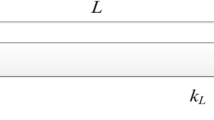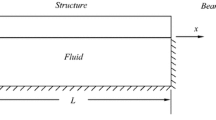Abstract
A differential quadrature procedure is proposed to study the steady state linear and nonlinear vibrations of an infinite beam resting on an elastic Winkler foundation and subjected to a moving point load. The governing nonlinear partial differential equation of motion of the beam is first expressed with respect to a moving coordinate system. This step reduces the governing nonlinear partial differential equation of motion of the beam to an ordinary nonlinear differential equation. This equation is then converted to a set of nonlinear algebraic equations by application of the differential quadrature method. The Newton–Raphson method is used to solve the resultant system of nonlinear algebraic equations. Issues related to implementation of infinite boundary conditions and modeling the point load are addressed. To accurately predict the dynamic behavior of the beam at high speeds of the moving point load, an efficient and robust absorbing boundary condition is also introduced. The fast rate of convergence of the method is demonstrated and to verify its accuracy, comparison study with available analytical solutions in the literature is performed. Numerical results reveal that the proposed procedure can be used as an effective tool for handling nonlinear moving load problems on infinite domains.
















Similar content being viewed by others
References
Fryba L (1999) Vibration of solids and structures under moving loads, 3rd edn. Thomas Telford Ltd, London
Timoshenko S (1926) Method of analysis of statical and dynamical stresses in rail. In: Proceedings of the second international conference for applied mechanics, Zurich, Switzerland, pp 407–418
Kenney JT (1954) Steady-state vibrations of beam on elastic foundation for moving load. ASME J Appl Mech 21:359–364
Duffy DG (1990) The response of an infinite railroad track to a moving, vibrating mass. ASME J Appl Mech 57:66–73
Mackertich S (1997) The response of an elastically supported infinite Timoshenko beam to a moving vibrating mass. J Acoust Soc Amer 101:337–340
Sun L, Deng X (1998) Dynamic analysis to infinite beam under a moving line load with uniform velocity. Appl Math Mech 19(4):367–373
Chen Y-H, Huang Y-H (2000) Dynamic stiffness of infinite Timoshenko beam on viscoelastic foundation in moving co-ordinate. Int J Numer Methods Eng 48:1–18
Andersen L, Nielsen SRK, Kirkegaard PH (2001) Finite element modelling of infinite Euler beams on Kelvin foundations exposed to moving loads in convected co-ordinates. J Sound Vib 241(4):587–604
Sun L (2002) A closed-form solution of beam on viscoelastic subgrade subjected to moving loads. Comput Struct 80:1–8
Nguyen V-H, Duhamel D (2006) Finite element procedures for nonlinear structures in moving coordinates. Part I: infinite bar under moving axial loads. Comput Struct 84:1368–1380
Nguyen V-H, Duhamel D (2008) Finite element procedures for nonlinear structures in moving coordinates. Part II: infinite beam under moving harmonic loads. Comput Struct 86:2056–2063
Ma X, Butterworth JW, Clifton GC (2009) Static analysis of an infinite beam resting on a tensionless Pasternak foundation. Eur J Mech A/Solids 28(4):697–703
Ma X, Butterworth JW, Clifton GC (2009) Response of an infinite beam resting on a tensionless elastic foundation subjected to arbitrarily complex transverse loads. Mech Res Commun 36(7):818–825
Patil VA, Sawant VA, Deb K (2010) Use of finite and infinite elements in static analysis of pavement. Interact Multi Mech 3(1):95–110
Uzzal RUA, Bhat RB, Ahmed W (2012) Dynamic response of a beam subjected to moving load and moving mass supported by Pasternak foundation. Shock Vib 19:205–220
Jang TS, Sung HG (2012) A new semi-analytical method for the non-linear static analysis of an infinite beam on a non-linear elastic foundation: a general approach to a variable beam cross-section. Int J Non-Linear Mech 47(4):132–139
Jang TS (2013) A new semi-analytical approach to large deflections of Bernoulli–Euler–V. Karman beams on a linear elastic foundation: nonlinear analysis of infinite beams. Int J Mech Sci 66:22–32
Jang TS (2014) A general method for analyzing moderately large deflections of a non-uniform beam: an infinite Bernoulli–Euler–Von Kármán beam on a nonlinear elastic foundation. Acta Mech 7:1967–1984
Basu D, Kameswara Rao NSV (2013) Analytical solutions for Euler–Bernoulli beam on viscoelastic foundation subjected to moving load. Int J Numer Anal Meth Geomech 37(8):945–960
Reddy JN (2004) An introduction to nonlinear finite element analysis. Oxford University Press, New York
Bellman RE, Casti J (1971) Differential quadrature and long term integrations. J Math Anal Appl 34:235–238
Bellman RE, Kashef BG, Casti J (1972) Differential quadrature: a technique for the rapid solution of nonlinear partial differential equations. Comput Phys 10:40–52
Bert CW, Malik M (1996) Differential quadrature method in computational mechanics: a review. Appl Mech Rev 49:1–28
Shu C (2000) Differential quadrature and its application in engineering. Springer, New York
Shu C, Ding H, Yeo KS (2004) Solution of partial differential equations by a global radial basis function-based differential quadrature method. Eng Anal Bound Elem 28:1217–1226
Zong Z, Zhang Y (2009) Advanced differential quadrature methods. Chapman & Hall, New York
Eftekhari SA, Jafari AA (2012) Numerical simulation of chaotic dynamical systems by the method of differential quadrature. Sci Iran B 19(5):1299–1315
Eftekhari SA, Jafari AA (2013) Numerical solution of general boundary layer problems by the method of differential quadrature. Sci Iran B 20(4):1278–1301
Fantuzzi N, Tornabene F, Viola E (2014) Generalized differential quadrature finite element method for vibration analysis of arbitrarily shaped membranes. Int J Mech Sci 79:216–251
Fantuzzi N, Tornabene F, Viola E, Ferreira AJM (2014) A strong formulation finite element method (SFEM) based on RBF and GDQ techniques for the static and dynamic analyses of laminated plates of arbitrary shape. Meccanica 49(10):2503–2542
Tornabene F, Fantuzzi N, Ubertini F, Viola E (2015) Strong formulation finite element method: a survey. ASME Appl Mech Rev 67:020801
Eftekhari SA, Jafari AA (2012) Coupling Ritz method and triangular quadrature rule for moving mass problem. ASME J Appl Mech 79(2):021018
Eftekhari SA, Jafari AA (2014) A mixed modal-differential quadrature method for free and forced vibration of beams in contact with fluid. Meccanica 49:535–564
Eftekhari SA (2016) Pressure-based and potential-based mixed Ritz-differential quadrature formulations for free and forced vibration of Timoshenko beams in contact with fluid. Meccanica 51:179–210
Quan JR, Chang CT (1989) New insights in solving distributed system equations by the quadrature methods, part I: analysis. Comput Chem Eng 13:779–788
Eftekhari SA (2015) A differential quadrature procedure with regularization of the Dirac-delta function for numerical solution of moving load problem. Latin Am J Solids Struct 12:1241–1265
Eftekhari SA (2015) A note on mathematical treatment of the Dirac-delta function in the differential quadrature bending and forced vibration analysis of beams and rectangular plates subjected to concentrated loads. Appl Math Model 39:6223–6242
Eftekhari SA (2015) A modified differential quadrature procedure for numerical solution of moving load problem. J Mech Eng Sci. doi:10.1177/0954406215584630
Tornabene F, Fantuzzi N, Bacciocchi M, Viola E (2015) A new approach for treating concentrated loads in doubly-curved composite deep shells with variable radii of curvature. Compos Struct 131:433–452
Jang SK, Bert CW, Striz AG (1989) Application of differential quadrature to static analysis of structural components. Int J Numer Methods Eng 28:561–577
Malik M, Bert CW (1996) Implementing multiple boundary conditions in the DQ solution of higher-order PDE’s: application to free vibration of plates. Int J Numer Methods Eng 39:1237–1258
Shu C, Du H (1997) A generalized approach for implementing general boundary conditions in the GDQ free vibration analyses of plates. Int J Solids Struct 34(7):837–846
Eftekhari SA (2015) A simple and accurate mixed Ritz-DQM formulation for free vibration of rectangular plates involving free corners. Ain Shams Eng J. doi:10.1016/j.asej.2015.05.016
Mallik AK, Chandra S, Singh Avinash B (2006) Steady-state response of an elastically supported infinite beam to a moving load. J Sound Vib 291:1148–1169
Author information
Authors and Affiliations
Corresponding author
Appendices
Appendix 1: Discretization of the Dirac-delta function using the coupled DQM/IQM approach
Consider n grid points with coordinates η 1, η 2,…,η n in the η-direction. Let
The Dirac-delta function has the following properties
It is possible to represent the source point (30) by two statically equivalent source points at the grid points located near the source acting point. Thus, Eq. (30) can be rewritten as [37, 38]
In view of Eq. (32), Eq. (34) can be written as
Integrating Eq. (34) numerically and using Eq. (33) we obtain
where W k-1 and W k are the integral quadrature weights correspond to the grid points η k-1 and η k , respectively. When the iterated trapezoidal rule is employed to integrate Eq. (34) numerically, these weights are obtained as
Appendix 2: Implementation of boundary conditions of the infinite beam
As pointed out earlier, the approach proposed in Ref. [41] is used herein to implement the boundary conditions of the infinite beam. In this approach (say, MWCM approach), the derivative boundary conditions are applied by Modification of the DQM Weighting Coefficient Matrices. The derivative boundary conditions of the infinite beam are
To implement the derivative boundary condition (38), we define
The second-order DQM weighting coefficient matrix is then obtained as
The derivative boundary condition (39) can be implemented if we define
The DQM weighting coefficient matrix of the third-order is obtained as
Similarly, the derivative boundary condition (40) is implemented as
Finally, the fourth-order DQM weighting coefficient matrix is obtained as
As it can be seen, the implementation of derivative boundary conditions in the MWCM approach is very simple and straightforward.
Rights and permissions
About this article
Cite this article
Eftekhari, S.A. A differential quadrature procedure for linear and nonlinear steady state vibrations of infinite beams traversed by a moving point load. Meccanica 51, 2417–2434 (2016). https://doi.org/10.1007/s11012-016-0373-7
Received:
Accepted:
Published:
Issue Date:
DOI: https://doi.org/10.1007/s11012-016-0373-7




